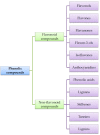The Potential of Plant Phenolics in Prevention and Therapy of Skin Disorders
- PMID: 26901191
- PMCID: PMC4783894
- DOI: 10.3390/ijms17020160
The Potential of Plant Phenolics in Prevention and Therapy of Skin Disorders
Abstract
Phenolic compounds constitute a group of secondary metabolites which have important functions in plants. Besides the beneficial effects on the plant host, phenolic metabolites (polyphenols) exhibit a series of biological properties that influence the human in a health-promoting manner. Evidence suggests that people can benefit from plant phenolics obtained either by the diet or through skin application, because they can alleviate symptoms and inhibit the development of various skin disorders. Due to their natural origin and low toxicity, phenolic compounds are a promising tool in eliminating the causes and effects of skin aging, skin diseases, and skin damage, including wounds and burns. Polyphenols also act protectively and help prevent or attenuate the progression of certain skin disorders, both embarrassing minor problems (e.g., wrinkles, acne) or serious, potentially life-threatening diseases such as cancer. This paper reviews the latest reports on the potential therapy of skin disorders through treatment with phenolic compounds, considering mostly a single specific compound or a combination of compounds in a plant extract.
Keywords: anti-aging properties; anti-carcinogenic; anti-inflammatory; antimicrobial; antioxidant; phenolic compounds; skin diseases; wound healing.
Figures











Similar articles
-
Role of Phenolic Compounds in Human Disease: Current Knowledge and Future Prospects.Molecules. 2021 Dec 30;27(1):233. doi: 10.3390/molecules27010233. Molecules. 2021. PMID: 35011465 Free PMC article. Review.
-
Plant Phenolics in the Prevention and Therapy of Acne: A Comprehensive Review.Molecules. 2024 Sep 6;29(17):4234. doi: 10.3390/molecules29174234. Molecules. 2024. PMID: 39275081 Free PMC article. Review.
-
Topical application of St. John's wort (Hypericum perforatum).Planta Med. 2014 Feb;80(2-3):109-20. doi: 10.1055/s-0033-1351019. Epub 2013 Nov 8. Planta Med. 2014. PMID: 24214835 Review.
-
Evaluation of wound healing property of Caesalpinia mimosoides Lam.J Ethnopharmacol. 2016 Dec 4;193:712-724. doi: 10.1016/j.jep.2016.10.009. Epub 2016 Oct 5. J Ethnopharmacol. 2016. PMID: 27717906
-
The Promising Role of Polyphenols in Skin Disorders.Molecules. 2024 Feb 15;29(4):865. doi: 10.3390/molecules29040865. Molecules. 2024. PMID: 38398617 Free PMC article. Review.
Cited by
-
Evaluation of anti-oxidant and antimelanogenic effects of the essential oil and extracts of Rosa × damascena in B16F10 murine melanoma cell line.Iran J Basic Med Sci. 2023;26(9):1076-1082. doi: 10.22038/IJBMS.2023.69734.15182. Iran J Basic Med Sci. 2023. PMID: 37605721 Free PMC article.
-
Comparative Study of Cytotoxicity and Antioxidant, Anti-Aging and Antibacterial Properties of Unfermented and Fermented Extract of Cornus mas L.Int J Mol Sci. 2023 Aug 26;24(17):13232. doi: 10.3390/ijms241713232. Int J Mol Sci. 2023. PMID: 37686038 Free PMC article.
-
Phenolic Bioactives as Antiplatelet Aggregation Factors: The Pivotal Ingredients in Maintaining Cardiovascular Health.Oxid Med Cell Longev. 2021 Aug 17;2021:2195902. doi: 10.1155/2021/2195902. eCollection 2021. Oxid Med Cell Longev. 2021. PMID: 34447485 Free PMC article. Review.
-
Phytobioactive compounds as therapeutic agents for human diseases: A review.Food Sci Nutr. 2023 Apr 17;11(6):2500-2529. doi: 10.1002/fsn3.3308. eCollection 2023 Jun. Food Sci Nutr. 2023. PMID: 37324906 Free PMC article. Review.
-
Comparison of Anti-Inflammatory and Antibacterial Properties of Raphanus sativus L. Leaf and Root Kombucha-Fermented Extracts.Int J Mol Sci. 2024 May 22;25(11):5622. doi: 10.3390/ijms25115622. Int J Mol Sci. 2024. PMID: 38891811 Free PMC article.
References
Publication types
MeSH terms
Substances
LinkOut - more resources
Full Text Sources
Other Literature Sources
Medical

